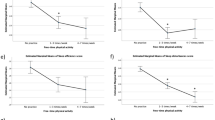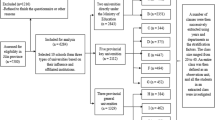Abstract
Purpose
Sleep presents a bi-directional relationship with numerous health factors and is frequently altered in university students due to stress, higher workload or screen use. The regular practice of physical activity (PA) could be an alternative treatment to improve sleep quality. The aim of the study was to determine if the potential benefic effect of physical activity on sleep is sex dependent.
Methods
Between 2017 and 2019, 1696 students (20.3 ± 4.6 years old) from University of Littoral Côte d’Opale and of a couple of paramedical training sites participated in this study. They completed self-report questionnaires including Pittsburgh Sleep Quality Index (PSQI) and Global Physical Activity Questionnaire. Two groups were defined according to PA level (high vs. low subjective PA level). Two-way ANCOVA was performed to test between-group differences and to identify potential interaction between sex and physical activity level in PSQI score.
Results
Women have a significantly higher PSQI score than men (6.43 ± 3.16 v 5.10 ± 2.92; p < 0.001). They are also more likely than men to be below recommended PA levels (26.3%v 6.66%; p < 0.001). People who have high PA level have lower PSQI score than people with low PA level (p = 0.007). Moreover, there are no gender differences in relation to the association between sleep quality and physical activity level.
Conclusion
Students who were more active reported sleeping better than less active students, this relationship was found for women and men. Thus, to promote regular practice of physical activity is necessary to improve sleep quality.

Similar content being viewed by others
References
Hicks T, Heastie S (2008) High school to college transition: a profile of the stressors, physical and psychological health issues that affect the first-year on-campus college student
Wolfson AR, Carskadon MA (2003) Understanding adolescents’ sleep patterns and school performance: a critical appraisal. Sleep Med Rev 7(6):491–506. https://doi.org/10.1016/s1087-0792(03)90003-7
Léger D, Roscoat ED, Bayon V, Guignard R, Pâquereau J, Beck F (2011) Short sleep in young adults: insomnia or sleep debt? Prevalence and clinical description of short sleep in a representative sample of 1004 young adults from France. Sleep Med 12(5):454–462. https://doi.org/10.1016/j.sleep.2010.12.012
Carskadon MA, Dement WC (1981) Cumulative effects of sleep restriction on daytime sleepiness. Psychophysiology 18(2):107–113. https://doi.org/10.1111/j.1469-8986.1981.tb02921.x
Van Dongen HP, Maislin G, Mullington JM, Dinges DF (2003) The cumulative cost of additional wakefulness: dose-response effects on neurobehavioral functions and sleep physiology from chronic sleep restriction and total sleep deprivation. Sleep 26(2):117–126. https://doi.org/10.1093/sleep/26.2.117
Gaultney JF (2010) The prevalence of sleep disorders in college students: impact on academic performance. J Am Coll Health 59(2):91–97. https://doi.org/10.1080/07448481.2010.483708
James SM, Honn KA, Gaddameedhi S, Van Dongen H (2017) Shift work: disrupted circadian rhythms and sleep-implications for health and well-being. Curr Sleep Med Rep 3(2):104–112. https://doi.org/10.1007/s40675-017-0071-6
Núñez P, Perillan C, Arguelles J, Diaz E (2019) Comparison of sleep and chronotype between senior and undergraduate university students. Chronobiol Int 36(12):1626–1637. https://doi.org/10.1080/07420528.2019.1660359
Sun J, Chen M, Cai W, Wang Z, Wu S, Sun X, Liu H (2019) Chronotype: implications for sleep quality in medical students. Chronobiol Int 36(8):1115–1123. https://doi.org/10.1080/07420528.2019.1619181
Rique GL, Fernandes Filho GM, Ferreira AD, de Sousa-Muñoz RL (2014) Relationship between chronotype and quality of sleep in medical students at the Federal University of Paraiba, Brazil. Sleep Sci (Sao Paulo, Brazil) 7(2):96–102. https://doi.org/10.1016/j.slsci.2014.09.004
Montaruli A, Castelli L, Galasso L, Mulè A, Bruno E, Esposito F, Caumo A, Roveda E (2019) Effect of chronotype on academic achievement in a sample of Italian University students. Chronobiol Int 36(11):1482–1495. https://doi.org/10.1080/07420528.2019.1652831
Enright T, Refinetti R (2017) Chronotype, class times, and academic achievement of university students. Chronobiol Int 34(4):445–450. https://doi.org/10.1080/07420528.2017.1281287
Sa J, Samuel T, Chaput JP, Chung J, Grigsby-Toussaint DS, Lee J (2020) Sex and racial/ethnic differences in sleep quality and its relationship with body weight status among US college students. J Am Coll Health 68(7):704–711. https://doi.org/10.1080/07448481.2019.1594829
Suh S, Cho N, Zhang J (2018) Sex differences in insomnia: from epidemiology and etiology to intervention. Curr Psychiatry Rep 20(9):69. https://doi.org/10.1007/s11920-018-0940-9
Concha-Cisternas Y, Guzmán-Muñoz E, Valdés-Badilla P, Lira-Cea C, Petermann F, Celis-Morales C (2018) Factores de riesgo asociados a bajo nivel de actividad física y exceso de peso corporal en estudiantes universitarios [Levels of physical activity and excess body weight in university students]. Rev Med Chil 146(8):840–849. https://doi.org/10.4067/s0034-98872018000800840
Chennaoui M, Arnal PJ, Sauvet F, Léger D (2015) Sleep and exercise: a reciprocal issue? Sleep Med Rev 20:59–72. https://doi.org/10.1016/j.smrv.2014.06.008
Baron KG, Reid KJ, Zee PC (2013) Exercise to improve sleep in insomnia: exploration of the bidirectional effects. J Clin Sleep Med 9(8):819–824. https://doi.org/10.5664/jcsm.2930
Kelley GA, Kelley KS (2017) Exercise and sleep: a systematic review of previous meta-analyses. J Evid Based Med 10(1):26–36. https://doi.org/10.1111/jebm.12236
Hurdiel R, Watier T, Honn K, Pezé T, Zunquin G, Theunynck D (2017) Effects of a 12-week physical activities programme on sleep in female university students. Res Sports Med (Print) 25(2):191–196. https://doi.org/10.1080/15438627.2017.1282354
Rogers LQ, Courneya KS, Oster RA, Anton PM, Robbs RS, Forero A, McAuley E (2017) Physical activity and sleep quality in breast cancer survivors: a randomized trial. Med Sci Sports Exerc 49(10):2009–2015. https://doi.org/10.1249/MSS.0000000000001327
Hirata RP, Dala Pola DC, Schneider LP, Bertoche MP, Furlanetto KC, Hernandes NA, Mesas AE, Pitta F (2020) Tossing and turning: association of sleep quantity-quality with physical activity in COPD. ERJ Open Res 6(4):00370–02020. https://doi.org/10.1183/23120541.00370-2020
Lang C, Brand S, Feldmeth AK, Holsboer-Trachsler E, Pühse U, Gerber M (2013) Increased self-reported and objectively assessed physical activity predict sleep quality among adolescents. Physiol Behav 120:46–53. https://doi.org/10.1016/j.physbeh.2013.07.001
Oudegeest-Sander MH, Eijsvogels TH, Verheggen RJ, Poelkens F, Hopman MT, Jones H, Thijssen DH (2013) Impact of physical fitness and daily energy expenditure on sleep efficiency in young and older humans. Gerontology 59(1):8–16. https://doi.org/10.1159/000342213
Wennman H, Kronholm E, Partonen T, Tolvanen A, Peltonen M, Vasankari T, Borodulin K (2014) Physical activity and sleep profiles in Finnish men and women. BMC Public Health 14:82. https://doi.org/10.1186/1471-2458-14-82
Kredlow MA, Capozzoli MC, Hearon BA, Calkins AW, Otto MW (2015) The effects of physical activity on sleep: a meta-analytic review. J Behav Med 38(3):427–449. https://doi.org/10.1007/s10865-015-9617-6
Vitale JA, Bonato M, Galasso L, La Torre A, Merati G, Montaruli A, Roveda E, Carandente F (2017) Sleep quality and high intensity interval training at two different times of day: a crossover study on the influence of the chronotype in male collegiate soccer players. Chronobiol Int 34(2):260–268. https://doi.org/10.1080/07420528.2016.1256301
Bonato M, La Torre A, Marventano I, Saresella M, Merati G, Banfi G, Vitale JA (2020) Effect of high-intensity interval training versus small-sided games training on sleep and salivary cortisol level. Int J Sports Physiol Perform. https://doi.org/10.1123/ijspp.2019-0498
Caspersen CJ, Pereira MA, Curran KM (2000) Changes in physical activity patterns in the United States, by sex and cross-sectional age. Med Sci Sports Exerc 32(9):1601–1609. https://doi.org/10.1097/00005768-200009000-00013
Blais FC, Gendron L, Mimeault V, Morin CM (1997) Evaluation de l’insomnie: validation de trois questionnaires [Evaluation of insomnia: validity of 3 questionnaires]. L’Encephale 23(6):447–453
Buysse DJ, Reynolds CF 3rd, Monk TH, Berman SR, Kupfer DJ (1989) The Pittsburgh Sleep Quality Index: a new instrument for psychiatric practice and research. Psychiatry Res 28(2):193–213. https://doi.org/10.1016/0165-1781(89)90047-4
Bull FC, Maslin TS, Armstrong T (2009) Global physical activity questionnaire (GPAQ): nine country reliability and validity study. J Phys Act Health 6(6):790–804. https://doi.org/10.1123/jpah.6.6.790
Rivière F, Widad FZ, Speyer E, Erpelding ML, Escalon H, Vuillemin A (2018) Reliability and validity of the French version of the global physical activity questionnaire. J Sport Health Sci 7(3):339–345. https://doi.org/10.1016/j.jshs.2016.08.004
Pate RR, Pratt M, Blair SN, Haskell WL, Macera CA, Bouchard C, Buchner D, Ettinger W, Heath GW, King AC (1995) Physical activity and public health. A recommendation from the Centers for Disease Control and Prevention and the American College of Sports Medicine. JAMA 273(5):402–407. https://doi.org/10.1001/jama.273.5.402
Lund HG, Reider BD, Whiting AB, Prichard JR (2010) Sleep patterns and predictors of disturbed sleep in a large population of college students. J Adolesc Health 46(2):124–132. https://doi.org/10.1016/j.jadohealth.2009.06.016
Dąbrowska-Galas M, Ptaszkowski K, Dąbrowska J (2021) Physical activity level, insomnia and related impact in medical students in Poland. Int J Environ Res Public Health 18(6):3081. https://doi.org/10.3390/ijerph18063081
Galland BC, Taylor BJ, Elder DE, Herbison P (2012) Normal sleep patterns in infants and children: a systematic review of observational studies. Sleep Med Rev 16(3):213–222. https://doi.org/10.1016/j.smrv.2011.06.001
Roenneberg T, Kuehnle T, Pramstaller PP, Ricken J, Havel M, Guth A, Merrow M (2004) A marker for the end of adolescence. Curr Biol 14(24):R1038–R1039. https://doi.org/10.1016/j.cub.2004.11.039
Gordon-Larsen P, Nelson MC, Popkin BM (2004) Longitudinal physical activity and sedentary behavior trends: adolescence to adulthood. Am J Prev Med 27(4):277–283. https://doi.org/10.1016/j.amepre.2004.07.006
Banno M, Harada Y, Taniguchi M, Tobita R, Tsujimoto H, Tsujimoto Y, Kataoka Y, Noda A (2018) Exercise can improve sleep quality: a systematic review and meta-analysis. PeerJ 6:e5172. https://doi.org/10.7717/peerj.5172
Kim K, Uchiyama M, Okawa M, Liu X, Ogihara R (2000) An epidemiological study of insomnia among the Japanese general population. Sleep 23(1):41–47
Lang C, Kalak N, Brand S, Holsboer-Trachsler E, Pühse U, Gerber M (2016) The relationship between physical activity and sleep from mid adolescence to early adulthood. A systematic review of methodological approaches and meta-analysis. Sleep Med Rev 28:32–45. https://doi.org/10.1016/j.smrv.2015.07.004
Memon AR, Gupta CC, Crowther ME, Ferguson SA, Tuckwell GA, Vincent GE (2021) Sleep and physical activity in university students: a systematic review and meta-analysis. Sleep Med Rev 58:101482. https://doi.org/10.1016/j.smrv.2021.101482
Lins-Filho O, Lyra MJ, Kline CE (2022) Exercise and sleep. In: Frange C, Coelho FMS (eds) Sleep medicine and physical therapy. Springer, Cham. https://doi.org/10.1007/978-3-030-85074-6_29
Van Reeth O, Sturis J, Byrne MM, Blackman JD, L’Hermite-Balériaux M, Leproult R, Oliner C, Refetoff S, Turek FW, Van Cauter E (1994) Nocturnal exercise phase delays circadian rhythms of melatonin and thyrotropin secretion in normal men. Am J Physiol 266(6 Pt 1):E964–E974. https://doi.org/10.1152/ajpendo.1994.266.6.E964
Yamanaka Y, Hashimoto S, Takasu NN, Tanahashi Y, Nishide SY, Honma S, Honma K (2015) Morning and evening physical exercise differentially regulate the autonomic nervous system during nocturnal sleep in humans. Am J Physiol Regul Integr Comp Physiol 309(9):R1112–R1121. https://doi.org/10.1152/ajpregu.00127.2015
Irwin MR, Opp MR (2017) Sleep health: reciprocal regulation of sleep and innate immunity. Neuropsychopharmacology 42(1):129–155. https://doi.org/10.1038/npp.2016.148
Zhai X, Wu N, Koriyama S, Wang C, Shi M, Huang T, Wang K, Sawada SS, Fan X (2021) Mediating effect of perceived stress on the association between physical activity and sleep quality among Chinese College Students. Int J Environ Res Public Health 18(1):289. https://doi.org/10.3390/ijerph18010289
Cheng HP, Chen CH, Lin MH, Wang CS, Yang YC, Lu FH, Wu JS, Lin SI (2019) Gender differences in the relationship between walking activity and sleep disturbance among community-dwelling older adult with diabetes in Taiwan. J Women Aging 31(2):108–116. https://doi.org/10.1080/08952841.2017.1413830
Sullivan Bisson AN, Robinson SA, Lachman ME (2019) Walk to a better night of sleep: testing the relationship between physical activity and sleep. Sleep Health 5(5):487–494. https://doi.org/10.1016/j.sleh.2019.06.003
Vitale JA, Weydahl A (2017) Chronotype, physical activity, and sport performance: a systematic review. Sports Med (Auckland, N.Z.) 47(9):1859–1868. https://doi.org/10.1007/s40279-017-0741-z
Vitale JA, Banfi G, La Torre A, Bonato M (2018) Effect of a habitual late-evening physical task on sleep quality in neither-type soccer players. Front Physiol 9:1582. https://doi.org/10.3389/fphys.2018.01582
Vitale JA, La Torre A, Banfi G, Bonato M (2019) Acute sleep hygiene strategy improves objective sleep latency following a late-evening soccer-specific training session: a randomized controlled trial. J Sports Sci 37(23):2711–2719. https://doi.org/10.1080/02640414.2019.1661938
Acknowledgements
Facilities were provided by the University of the Littoral Opal Coast. We gratefully thank the sports department students who helped for the data collection.
Funding
The Universanté project was supported by the Mutualité Francaise (agency that participates in the French Health System) and the Nord-Pas-de-Calais region, in which the research was conducted.
Author information
Authors and Affiliations
Corresponding author
Ethics declarations
Conflict of interest
We have no conflict of interest to declare.
Ethical approval
Permission to conduct the study was granted by the ethics committee of the University of Littoral Côte d'Opale.
Informed consent
Students were informed of the scope of the study and volunteers received an information letter and signed a written consent form.
Additional information
Publisher's Note
Springer Nature remains neutral with regard to jurisdictional claims in published maps and institutional affiliations.
Rights and permissions
About this article
Cite this article
Baron, P., Hermand, É., Peze, T. et al. No gender difference in association between sleep quality and physical activity level of French students. Sport Sci Health 19, 277–283 (2023). https://doi.org/10.1007/s11332-022-00920-5
Received:
Accepted:
Published:
Issue Date:
DOI: https://doi.org/10.1007/s11332-022-00920-5




